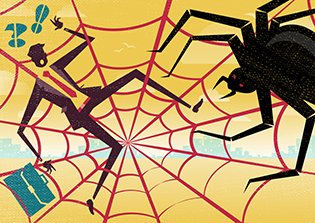Beyond “bad apples” and “crooked executives”

Large-scale corporate scandals continue making front-page news. The last 12 months have seen reports of software manipulation by two automakers, allegations of contribution to money laundering at Deutsche Bank, corruption allegations at Rolls-Royce and Airbus, and self-certification allegations at Boeing – to name just a few.
People invoke two explanations for large-scale unethical behavior in organizations: That there are a few individuals – “a few bad apples” – who don’t have the right values, the right ethics, and who are solely to be blamed. This is often the narrative from the top of the organization, lamenting about the unfortunate and unfair conclusion that the organization and its entire workforce is under general suspicion. The other explanation suggests that wrongdoing is a result of explicit or implicit orders from crooked top executives. This is often the public narrative that reflects the inconceivability of many that large-scale unethical behavior may be possible without cognizance, involvement, or direct sanctioning by the top of the organization.
Moral disengagement theory (Bandura, 1999, 2016) offers a third – alternative or complementary – explanation. It posits that normal people – well-bred and well-intentioned – are able to engage in unethical behavior through cognitive reconstrual of their behavior.
What is moral disengagement?
Through moral disengagement, people can suspend or override moral principles that they in general accept as valid, enabling them to engage in behavior that is inconsistent with their moral principles yet is not seen as such. Moral disengagement theory was developed by social psychologist Albert Bandura and states that people generally act in line with – and refrain from conduct contrary to – internalized moral standards. These standards, that are previously acquired through social learning, however, can be suspended, they can be disengaged, and are then no longer effective in guiding people to do what’s right and to refrain from doing what’s wrong.
How moral disengagement works?
Moral disengagement operates through numerous cognitive mechanisms that change people’s assessment of the morality of behavior via three main strategies of reconstruing morality, reconstruing agency, and reconstruing events (Schaefer & Bouwmeester, 2019). Here are sketches of nine specific mechanisms relevant to organizational contexts.

Reconstruing morality
When people engage in reconstruing morality, they reevaluate behavior and convince themselves that the behavior is “not immoral” or even “morally obligatory.” To do so, people invoke an alternative moral frame according to which the unethical behavior in question becomes ethically justified (moral justification), or they weaken the moral frame that was invoked to establish a behavior as ethical (e.g., through legalism or condemning the condemner).
Through moral justification people draw on an alternative moral frame, for example, by reference to a religion, an ideology, or a higher obligation to a specific community that obligates an actor to show the behavior in question. To illustrate, a Siemens manager who contributed to the company’s corruption that surfaced in 2007 explained his behavior as wanting to help company and co-workers: “We did it for the company, it was about keeping the business unit alive and not jeopardizing thousands of jobs overnight” (Schubert & Miller, 2008).
People may alternatively defend behavior by arguing that explicit rules and laws can be the sole basis to establish a behavior or practice as wrong, and that allegations of immorality beyond the test of legality are without foundation. Legalism (Ashforth & Anand, 2003) allows people to argue that everything is allowed (and therefore justified) which is not explicitly forbidden by law. An illustration of this mechanism was provided by former Volkswagen CEO Müller in an interview with NPR (Glinton, 2016):
NPR: You said this was a technical problem, but the American people feel this is not a technical problem, this is an ethical problem that’s deep inside the company. How do you change that perception in the US?
Matthias Mueller: Frankly spoken, it was a technical problem. We made a default, we had a ... not the right interpretation of the American law. […] And the other question you mentioned – it was an ethical problem? I cannot understand why you say that.”
A third way to reconstrue morality is by condemning the condemner, whereby people deflect the condemnation of others by attacking the condemners, for example, by suggesting that condemners themselves are complicit, crooked, or corrupt. Automakers involved in emissions cheating have replied to condemnation from regulators and lawmakers by contending that they have been complicit in the past.
Reconstruing agency
When people engage in reconstruing agency, they psychologically distance themselves from the behavior by minimizing the actor’s agency in it. People may displace responsibility for behavior to authorities. Organizations characterized by hierarchies, frameworks of legitimizations, and high pay at the top to compensate for higher responsibility – provide ideal conditions for organizational members to displace responsibility.
People may alternatively diffuse responsibility across collectives. When people can point out that everyone is doing what they are doing, or that they only make a small, insignificant contribution to an unethical behavior, people can easily diffuse responsibility. Organizations provide an ideal breeding ground for the diffusion of responsibility: division of labor, teamwork, and shared decision making foster diffusion of responsibility. Siemens manager Siekaczek noted that “paying provisions and bribes was customary in practically all business units of Siemens AG” (Schubert & Miller, 2008). And in taking the decision to build a defeat device making diesel engines appear clean when they in fact were not, Volkswagen decision makers allegedly argued that “all the carmakers cheated. Volkswagen had to take shortcuts, too, or it wouldn’t be able to compete” (Ewing, 2018, p. 122).
Agency may be minimized by reference to contextual factors. When people blame forces outside the individual and beyond control, they minimize their own agency by depicting themselves as helpless, as driven and controlled by external forces. In large organizations, members may point to their own insignificance and powerlessness to rationalize tacit acceptance of, or active contribution to, unethical practice.

Reconstruing events (spinning)
When people are spinning, they reconstrue events and provide a biased interpretation of what happens. This class of moral disengagement mechanisms invokes practices of political spin, the sophisticated manipulative selling of ideas and interpretations aimed at controlling or influencing perceptions of a specific event, decision, or policy. Spinning alone may not be sufficient to fully rebut accusations of immorality, yet it may significantly diminish the force of such accusations.
Language plays an important role in reconstruing events, for example, via the application of linguistic devices and techniques, such as euphemisms, dysphemisms, catchphrases, metaphors, and the use of passive voice.
People may misconstrue consequences of their doing, or even deny detrimental outcomes altogether. To illustrate, engine developers at Volkswagen, involved in devising a defeat device, may contest allegations of unethical behavior on the ground that their fuel-efficient diesel was a promising way to fight climate change (Ewing 2017, p. 126). Advantageous comparison trivializes the immorality of specific behavior by enlarging the reference context and pointing to much larger transgressions (typically by others, e.g., adversaries). To illustrate, furthering sales of an admittedly manipulated, but fuel-efficient and CO2-minimizing modern diesel engine may appear good when compared to marketing “thirsty” gasoline-powered SUVs and pickup trucks.
The three main strategies – reconstruing morality, agency, and events – do not operate distinctly but may be effectively combined in achieving moral disengagement. Scholars identified 18 cognitive mechanisms through which moral disengagement is achieved (Schaefer & Bouwmeester, 2019).
What do we know about moral disengagement?
Research has established overwhelming support for the core proposition of moral disengagement theory, a close link between moral disengagement and unethical behavior. Moral disengagement predicts bullying, aggression, delinquency, support for war, cheating, counterproductive work behavior, unethical decision making, unethical work behavior, and unethical pro-organizational behavior. While most research showed how moral disengagement clears the way to transgressions, there is support for the reverse relationship too – that moral disengagement results from unethical behavior (Shu, Gino, & Bazerman, 2011)people justified their dishonest deeds through moral disengagement and exhibited motivated forgetting of information that might otherwise limit their dishonesty. Using hypothetical scenarios (Studies 1 and 2 and is used to rationalize unethical behavior after it has been committed. A dynamic “slippery- slope effect” between the two variables was experimentally established and we may speculate about a vicious circle that could be at work when unethical behavior drives moral disengagement, which in turn could spur more unethical behavior.
Collective moral disengagement
While moral disengagement research has initially took an individual level – intrapsychic –perspective, current research focuses on it as a collective phenomenon (Schaefer, 2019). In groups, organizations, or communities people may collectively reconstrue norms, agency, and events, thereby converging on the reevaluation of behavior formerly evaluated as unethical as justifiable. Such collective processes may free the way to collective unethical behavior, where members of a collective perform unethical behavior in concert with other members of that collective.
Moral disengagement reasoning may be shared and spread among organizational members. Collective moral disengagement may explain coordinated wrongdoing that group members carry out on behalf of the group – such as are required when many dozens of employees work together to develop and implement fraudulent software to achieve emissions cheating, or when thousands of employees engage in the very same unethical behavior of opening bank accounts without client permission (as was the case at Wells Fargo).
Why should we care?
“A few bad apples” or “the crook at the top” may be prominent as explanations for large-scale unethical behavior in organizations because they are easy explanations. Easy to understand and easy to deal with: just identify the bad guys, manage their exit, improve recruiting to exclude hiring bad guys again, implement a reporting system to identify the bad guys quicker, etc.
These easy explanations, however, may be misleading, and corresponding approaches may be ineffective in dealing with unethical behavior and preventing reoccurrence. Moral disengagement theory explains that normal, good people may get involved in large-scale unethical behavior and it predicts that people may not be aware that what they are doing is unethical. Understanding conditions under which morally disengaged thought spreads is of key importance.
Research has yet to collect more empirical data, but key hypotheses suggest that characteristics and conditions that most organizations desire are in fact catalysts of collective moral disengagement: high identification with the group or the organization; high group cohesiveness; high group or organizational attractiveness; and formal leaders who are also highly respected informal leaders. These generally most desirable social conditions may be also responsible for leading good people morally astray at the workplace.
Understanding individual and collective moral disengagement should be a top priority not only for business ethicists but for business executives too, seeking to effectively prevent large-scale unethical behavior to occur in their organization.
References
- Ashforth, B. E., & Anand, V. (2003). The Normalization of Corruption in Organizations. Research in Organizational Behavior, 25, 1–52. https://doi.org/10.1016/S0191-3085(03)25001-2
- Bandura, A. (1999). Moral disengagement in the Perpetration of Inhumanties. Personality and Social Psychology Review, 3(3), 193–209. https://doi.org/10.1080/0305724022014322
- Bandura, A. (2016). Moral disengagement. How people do harm and live with themselves. New York: Worth Publishers.
- Ewing, J. (2018). Faster, Higher, Farther: How One of the World’s Largest Automakers Committed a Massive and Stunning Fraud. New York: Norton & Company.
- Glinton, S. (2016). “We Didn’t Lie,” Volkswagen CEO Says Of Emissions Scandal. NPR.
- Schaefer, U. (2019). Group moral disengagement: A dynamic multilevel theory of emergence and outcomes of moral disengagement in groups (unpublished manuscript).
- Schaefer, U., & Bouwmeester, O. (2020). Reconceptualizing Moral Disengagement as a Process: Transcending Overly Liberal and Overly Conservative Practice in the Field. Journal of Business Ethics, 1-19.
- Schubert, S., & Miller, T. C. (2008). At Siemens, Bribery Was Just a Line Item - The New York Times. The New York Times.
- Shu, L. L., Gino, F., & Bazerman, M. H. (2011). Dishonest deed, clear conscience: When cheating leads to moral disengagement and motivated forgetting. Personality and Social Psychology Bulletin, 37(3), 330–349. https://doi.org/10.1177/0146167211398138